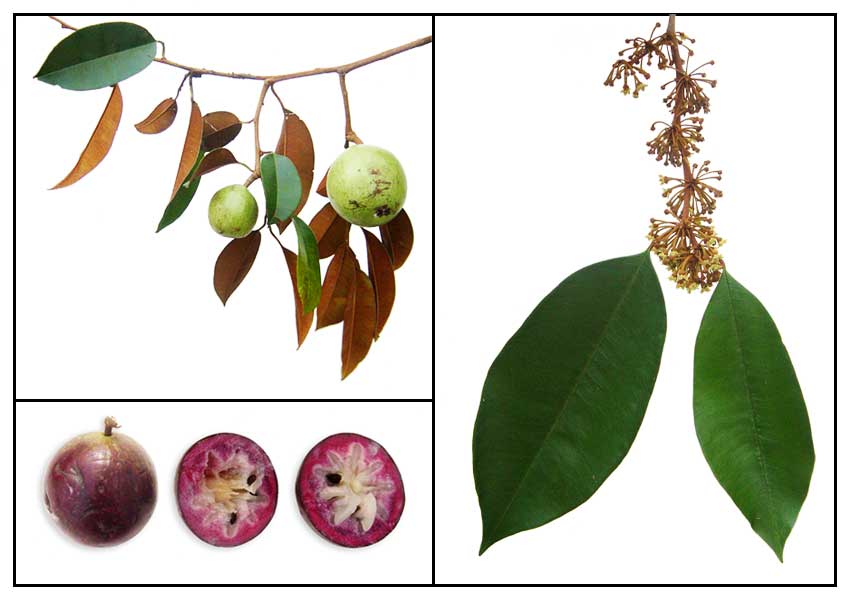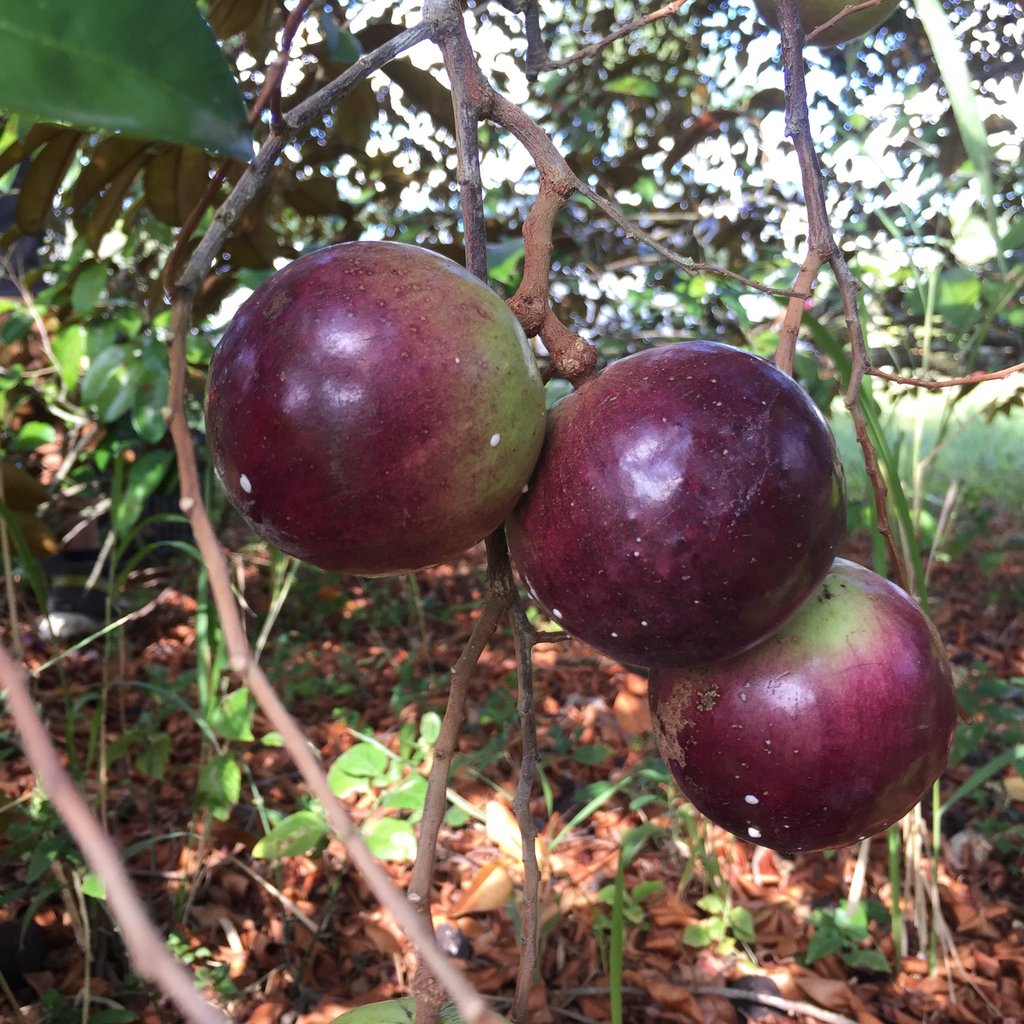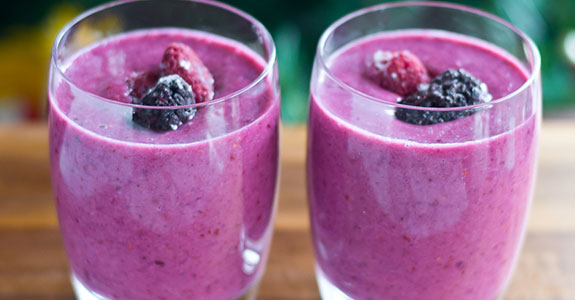With the Scientific name Chrysophyllum cainito, star apple is a fruit that is native to the Greater Antilles and is exclusively cultivated in South America (as evidenced by the many star apple trees we see about the place in Guyana), and the Caribbean such as Barbados, Jamaica, Haiti, among other countries.
And while we may know it as Star-apple here, it carries different names in different places; in Barbados its called Star Plum, in Belize Damsel and in Trinidad Caimite or Kaimit.

Start Appl | Image: http://www.stuartxchange.org/Caimito
The Fruit & Why Is It Called ‘Star Apple’
A star-apple tree is an evergreen tree which can reach heights of 8-20 meters, while the fruit grows between 5-10 cm in diameter, transitioning between yellowish green, greenish- purple and more commonly purple as it ripens.
Taking a closer look at the name, one who is unfamiliar with this tropical treat may ask why its called “star apple” when its shaped like an apple.
Now this question is easily answered but cutting open the fruit transversely which will reveal a fleshy, milky insides that also carries seed cells that are seen to radiate outwardly from a central core, producing a star-shaped pattern.
Now that we know why its called star apple, lets address why some refer to it as a selfish fruit. If you are familiar with a star apple tree, you may have noticed that there are times where even if the fruit is ripe, it does not “drop.”
Think about it, unlike other fruits like the beloved mango or even a coconut, which would drop or fall as it reaches optimum ripeness, a star apple stays attached to the tree until it is completely dried out.
Hence, some people think of it as being selfish.
Varieties of Star apples
- The Purple star apple

Purple Star Apple | https://www.7fruits.com.ng/product/star-apple/
Purple star apples have a thick skin attached to a rind, which is usually a dark purple color; the dark purple fruit is 6-12.5mm thick and has a soft, milky sweet pulp that ranges from a light purplish color to white.
- The Green star apple

Green Star Apple | https://www.shutterstock.com/video/clip-33795748-can-tho-vietnam-chrysophyllum-cainino-fruits-on
Unlike its purple counterpart, the green star apple has a thinner skin and rind; the leathery skin of this variety is often white and is 3-5mm thick with a soft and sweet pulp.
Health benefits of Star Apple
An Apple star offers 5 percent of the daily recommended values of important vitamins, such as vitamin C and vitamin A. It is a wonderful source of calcium, providing you with 10 percent of the daily recommended value of the mineral. However, there are so many other benefits of this fruit, some of which are given below.
- Digestive Health
Star apples are said to be a wonderful source of dietary fibers which make it a good option for one’s digestive system.
- Rich in Vitamin C
As with all the other vitamins, Vitamin C is essential to support several important functions in the human body as it acts as an antioxidant and is responsible for the production of collagen, healing wounds, protecting the heart, improve immune health, enhance vision, and decrease blood sugar levels in diabetic and more.
Further, since the human body cannot make vitamin C itself, it is important to consume this nutrient rich food. Apple star is one of those foods that have high content of vitamin C.
- Lose Weight
Being a fruit low fat and calories, the star apple is one of the best food choices to include in a weight loss diet. Furthermore, the high amount of dietary fiber in fruit improves its satiety and makes you feel more complete for long periods of time. This helps prevent over-eating, which is very important when you are trying to lose weight.
- Medicinal Drugs
According to a survey, the shell of the star apple tree has traditionally been used to treat malaria and yellow fever. The leaves have emollient properties and are used for the treatment of stomach pain, diarrhea and skin rash. In Western Nigeria, the cotyledons of the star apple seeds are used for the preparation of ointments for treatment of vaginal and skin infections.
Traditional uses for the star-apple
- It is taken as a remedy for diabetes mellitus, and a decoction is gargled to relieve angina.
- Undersides of leaves are grated and applied as a poultice to a wound and a leaf decoction is taken orally for hypoglycaemia.
- Decoction of the bark is given for dysentery in Mexico.
- Infusion of bark is tonic and refreshing in Costa Rica.
- Bitter seed sometime used as tonic, for diarrhea and fevers.
- Fruit is eaten for inflammation in laryngitis and pneumonia.
- Decoction of leaves used for hypertension in Ivory Costa.
- Leaf decoction is used for diabetes.
- Unripe fruit is used for intestinal problems in Venezuela.
- Decoction of bark is used as tonic and stimulant: use for diarrhea, dysentery, hemorrhages and treatment of gonorrhea.
- Cubans in Miami stated to use the leaf decoction for cancer treatment.
How to Eat
The ripe fruit is consumed fresh or preferably chilled, is cut in half and the flesh spooned out and eaten. However, it can also be used as an ingredient of ice cream and sherbet.
Interestingly in Jamaica it is occasionally made into preserves, while an An emulsion of the slightly bitter seed kernels is used to make an imitation of milk-of-almonds.
Important to note though is that the skin and the rind of the star apple are not edible as it has a bitter latex.
Something to try!
Gracious Living Star Apple Smoothie

Star Apple Smoothie | https://detoxdiy.com/detox-smoothie-recipes
Ingredients:
- 1-2 star fruits (without skin and pits)
- 1 tbsp tahini (sesame seed butter high in calcium & protein)
- Handful unsweetened, shredded coconut
- Raw honey to taste
- Cinnamon
- Cardamom
- 2-3 cups water or unsweetened coconut milk
- 1 cup ice
Instructions:
- Blend until creamy and smooth; It will come out a beautiful shade of purple.
- Sprinkle with cinnamon and enjoy!
Article References:
- https://www.healthbenefitstimes.com/star-apple/
- http://www.gracevanberkum.com/gracious-living-star-apple-smoothie/







